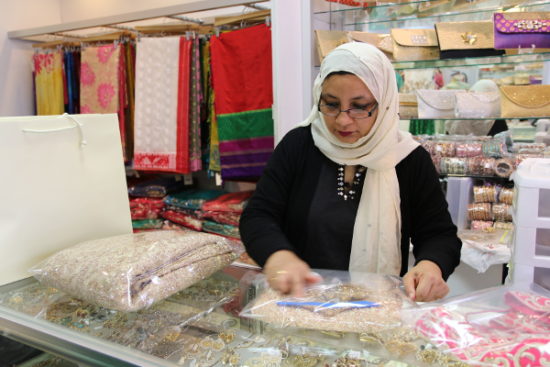A Jackson Heights boutique is where customers reconnect with their roots and introduce the younger generations to their cultural heritage.
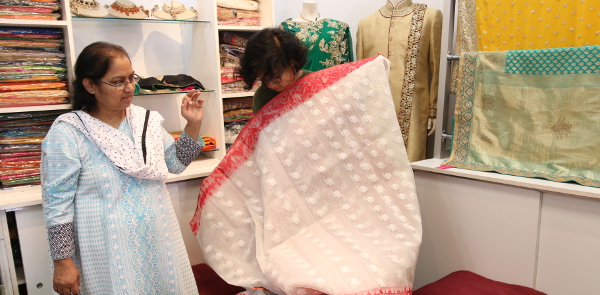
December 22, 2016
At the corner of Broadway and 74th Street, a Bangladeshi woman is opening the storefront gate to an unassuming shop filled with ornate sarees, shalwar kamise, and decorative jewelry. Within an hour of its opening on this Fall Saturday morning in October, a woman arrives to try on a custom lehenga – a wide, full skirt and sari petticoat – that she has ordered from the store.
“I think it fits better now,” says Mahima, a woman in her mid-20s who has been to the store since she was a child.
Nasreen Rahman gently pulls at the skirt and nods, noting where adjustments need to be made. “Okay beta [child], come pick this up in an hour.”
She sends her customer back into the changing room before being bombarded by two phone calls on different phones from other customers about orders. When speaking to each, she uses familial terms of endearment, demonstrating a care for her customers as if they were family.
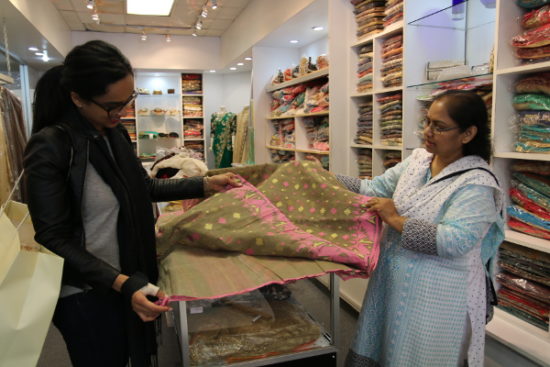
Nasreen Rahman is the owner of Pashmina Fashion, a sari boutique specializing in South Asian wedding and party-wear. If you google the store, you won’t find much. A barely used Facebook page with just one post is visible; it does not appear on Yelp nor does it have a website. And yet, Nasreen’s business is thriving. She’s served hundreds of customers every year, coming from across New York’s five boroughs, as well as New Jersey, Virginia, Washington D.C, and elsewhere.
Her customers are mostly South Asian immigrants – Indians, Bangladeshis, Nepalis, Pakistanis, Sri Lankans – and occasionally, Africans, Latin American-based buyers, and white Americans. She is known for her attentiveness to her clients, her knowledge of different sari types, and the festive and colorful patterns of her clothing.
At a low coffee table surrounded by cushions, she sits on a stool and spreads out dozens of different sarees for show. “This is a Jamdani saree from Bangladesh. It is traditionally woven fabric in cotton. They are very light. See the patterns and the shimmer?”
Watch Nasreen dicuss how she built her clientele through the years. (Video by Rahima Nasa)
She pulls out a different saree. “This is a Kota Jali saree. It’s more transparent and airy for the summer.”
“Banarasi sarees are known for their heavy gold embroider. And this one, the Gota saree, has lacework.”
She points out embroidered borders, smoothing her hands down silk and cotton. She folds them to have them put back in the storage room, which is floor to ceiling packed with different sarees and an ironing board where a female Bangla employee is ironing a purchased piece.
Nasreen’s entry into the world of textiles was somewhat arbitrary. In Bangladesh, she had worked as a town planner. In 1996, she moved to the United States with her two daughters and her husband. She already had family in Queens, so the transition was much smoother than it was for many immigrants coming to the U.S. for the first time.
While family set them up with a place to stay, the big question was how they would sustain themselves in their new home. In search of employment, she happened upon a saree store owned by a Pakistani woman who was looking to retire. Nasreen worked with the woman for a few months, and soon bought the place, making it her own. Pashmina Fashion was born on March 28, 1998.
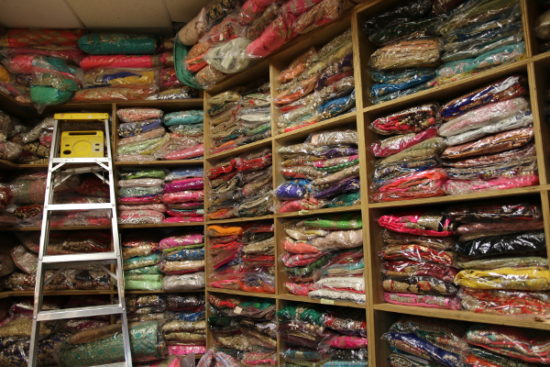
Nasreen’s husband, Mizanur, decided to support Nasreen’s business – doing the accounting, designing the store logo and signage, and taking care of their two children when Nasreen was at work.
“My parents didn’t have office jobs,” Shama, Nasreen’s youngest daughter said. “I went to school with people whose parents had nine-to-fives. My dad was the one who would pick us up, take care of afterschool snacks and homework. It was kind of a reversal of roles. I think my dad thinks that because he didn’t have a separate contribution, that he didn’t give us as much as he thought he would. But I think we got so much more because he was ever present. Especially in Bangladeshi culture… people can still be still so engrained in gender roles ”
The Rahman children – Shama and Karishma – spent most of their childhood in the saree shop, playing, napping after school, and listening to the chatter and bustle of customers. Shama, now 25, is now a marketing and social media expert at the Whitney Museum of Art, while the older Karishma is in medical school. Shama, who was in the store the day of the interview, said that she now realizes that her mother’s business taught her about fashion and how to be a marketer.
“I was always interested in fashion. I didn’t realize this was subconsciously related to that. I think we grew up thinking that ‘American’ was different from this fashion. In marketing, it’s so much about promoting but it’s also doing it in an honest way. It is about relationships and creating stories. In the beginning, I thought that this wasn’t part of the bigger conversation about textiles and fashion, but now I understand it to be part of that. Now I realize how the way my mom has done things influenced the way that I work.”
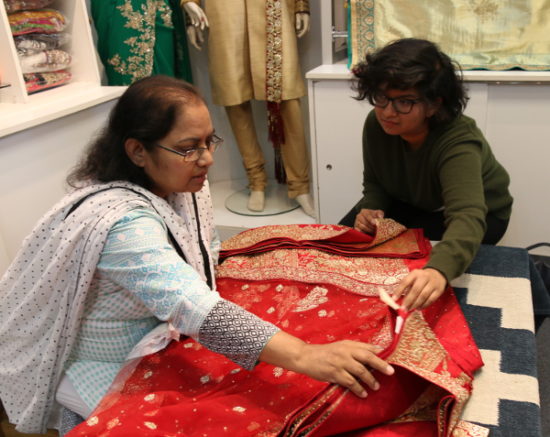
Shama was 5 years old when Nasreen and her father moved her and her older sister to the U.S. Nasreen’s brothers and sister had come to the U.S. earlier in the 1970s to study; her father had bought a house for them in Fresh Meadows to live together. Nasreen’s father worked in the Bangladeshi Air Force and had retired early and opened businesses in the U.S. and Bangladesh. The Rahman family moved into their family’s house in Fresh Meadows. They admit that for them, coming the U.S. was much easier because of their close family connections.
Yet, their new lives in the U.S. was a complete 360 from what they had known. Nasreen, who knew little about textiles, learned about selling sarees and bargaining with buyers in South Asia from the Pakistani woman she had bought the store from in 1998. It helped that Nasreen spoke several South Asian languages including Bangla, Hindi, and Urdu that allowed her to communicate with a variety of buyers, as well as her South Asian customers. “Language is very important,” Nasreen remarked, adding that it contributes to helping make her customers feel at home.
Above all, her care for her customers made her a favorite with customers across the East Coast and beyond. “She treats everyone like they are her children. She’s their Auntie,” Shama said of her mother.

When asked if Nasreen thinks she should have more of an online presence, she shrugs. “The customers always come,” she says.
Shama notes that one of the biggest adjustments Nasreen has had to make was allowing customers to take photos of the clothing. “My mom used to ask customers not to take pictures, unless someone had bought something. People used to take pictures and send it to their relatives and get the dress made for a cheaper price elsewhere. There were no smart phones then. But now, you can’t stop that. Sharing photos is an important part now of spreading the word about the store.”
Shama asks her mother, “Ma, do you feel okay with people taking pictures in the store with their cell phones?”
“I don’t feel okay but they take it anyway,” Nasreen replies. “I prefer people don’t take pictures. The dress doesn’t look complete if you don’t have your hair done and have no makeup. Sharing those photos doesn’t have the full effect.”
She moves on to helping a college-aged girl try on a lehenga choli for a dance performance. “Try these bangles on, they’ll match the skirt.” She fidgets and adjusts the dress before letting the girl look in the mirror. Upon seeing herself, the girl smiles and says she’ll buy both the lehenga and the bangles.
Nasreen’s assistant gently irons the lehenga before packaging it for travel. “If you have any trouble or need any more adjustments, call me,” says Nasreen.
The customer thanks her profusely. She said she’d be back and she would bring friends.
